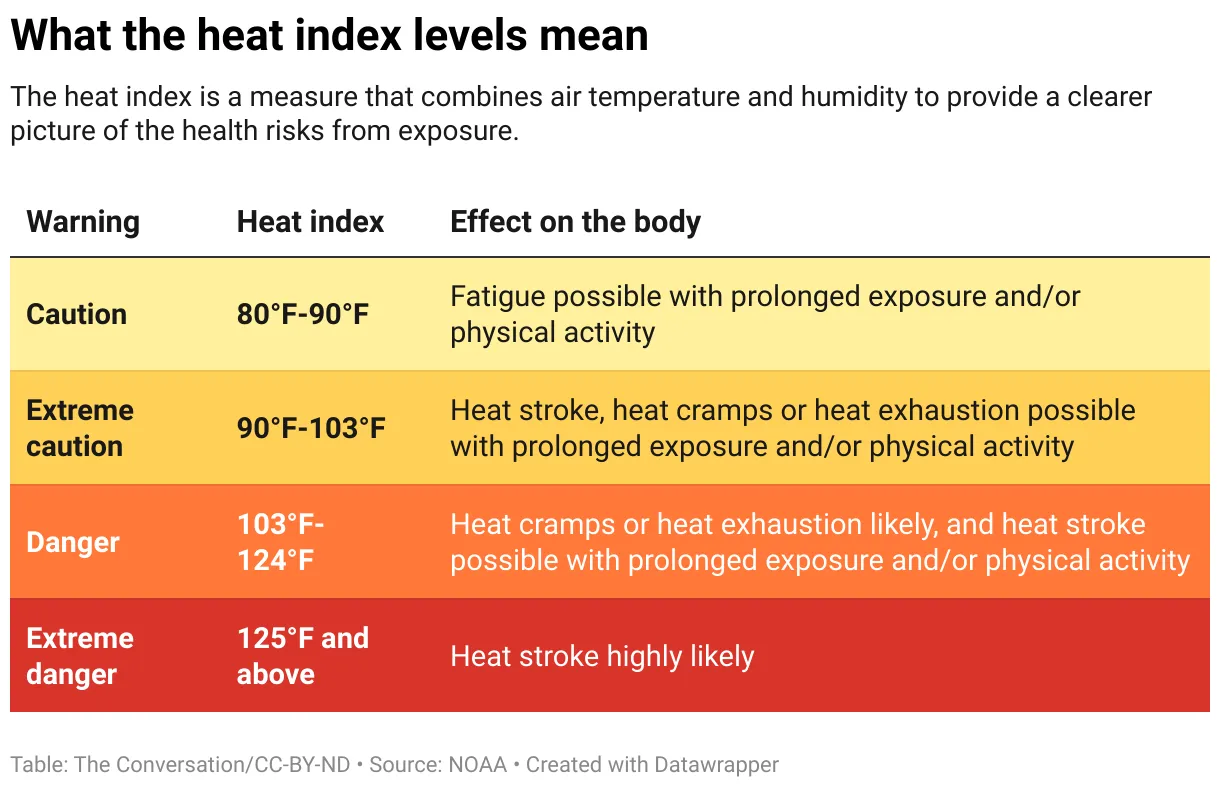June 7, 2024
Expert explains how to use the heat index and other weather tools to stay safe and healthy this summer
By Micki Olson

The Conversation table from NOAA data
The start of summer is an excellent time to create schedules and workloads based on heat safety. To get started, risk communication researcher Micki Olson reviews heat index warnings, including what they mean and how they can be used to understand how heat impacts the human body. She also gives tips on how to avoid heat-related illnesses.
What is the heat index? The heat index is the combination of the actual air temperature and relative humidity. "It tells you what it 'feels like' outside when you factor in the humidity. For example, if it's 98 degrees Fahrenheit (36.7 Celsius) with 55% relative humidity, it might feel more like a scorching 117 F (47.2 C)," Olson explains. "But there's a catch: Heat index is measured in shady conditions to prevent the sun's angle from affecting its calculation. This means if you're in direct sunlight, it will feel even hotter.
Apparent temperature is another "feels like" indicator; however, it factors in temperature, humidity and wind speed. "This means it can tell us both the heat index and wind chill – or the combination of the temperature and wind speed," Olson writes. "When conditions are humid, it feels hotter, and when it's windy, it feels colder."
Another term meteorologists use is the "wet bulb globe temperature," which includes temperature, humidity, wind and sunlight. Olson reports, "It's especially useful for those who spend time outdoors, such as workers and athletes, because it reflects conditions in direct sunlight."
HeatRisk is a forecasting tool the National Weather Service uses to provide a seven-day outlook for hot weather. The tool uses a five-level scale to indicate how risky the heat level is in a specific area. Each level uses a color and number to represent risks from heat exposure.
To stay safe during summer's sultry and sometimes oppressive heat, Olson recommends:
- Stay cool: Use air conditioning in your home, or spend time in air-conditioned spaces, such as a shopping mall or public library. Limit or reschedule your exercise and other outdoor plans that occur in the middle of the day when it is hottest.
- Stay hydrated: Drink more water than you might otherwise, even if you don’t feel thirsty, so your body can regulate its temperature by sweating. But avoid sugary drinks, caffeine or drinks with alcohol, because these can cause you to become dehydrated.
- Stay informed: Know the signs of heat illness and symptoms that can occur, such as dizziness, weakness, thirst, heavy sweating and nausea. Know what to do and when to get help, because heat illnesses can be deadly.
Micki Olson is a senior researcher in emergency and risk communication at the State University of New York. This excerpt was pulled from her contribution to The Conversation, a platform for journalism by academics. Her entire article and research can be found here.